
Villa Repeta is a patrician villa in Campiglia dei Berici, province of Vicenza, northern Italy. It was built in 1672, substituting a pre-existing villa designed by Italian Renaissance architect Andrea Palladio about 1557 and destroyed by a fire.

Villa Repeta is a patrician villa in Campiglia dei Berici, province of Vicenza, northern Italy. It was built in 1672, substituting a pre-existing villa designed by Italian Renaissance architect Andrea Palladio about 1557 and destroyed by a fire.

The villa which Palladio built for Mario Repeta – or at least the initial results of his building campaign – was destroyed by fire at an unspecified date, sometime between 1640 and 1672, when it was replaced by the existing new edifice. Therefore, Palladio’s Villa Repeta, designed around 1557, can only be reconstructed on the basis of the plate in the I quattro libri dell'architettura , although recent studies have raised serious doubts that the engraving can effectively correspond to the project. Rather they suggest that this plate represents Palladio’s usual, a posteriori, theoretical, re-elaboration of an idea, which was in reality compromised by major pre-existing features.
In any case, the project remains extraordinary among Palladio’s output: the structure has a continuous, Doric order, portico of only one storey, which develops entirely horizontally around a rectangular courtyard. The only vertical elements are the two dovecotes at the corners of the complex.
Without the usual hierarchical dialogue between a dominant manorial house and agricultural annexes, the design of the villa might represent the product of a precise initiative on the part of the patrons and reflect the heterodox and egalitarian ideas of the Repeta family (Mario Repeta was denounced to the Holy Office in 1569), restless protagonists in the public life of Vicenza during the 16th century.
The actual villa was built 1672 by Enea and Scipione Repeta.

Vincenzo Scamozzi was an Italian architect and a writer on architecture, active mainly in Vicenza and Republic of Venice area in the second half of the 16th century. He was perhaps the most important figure there between Andrea Palladio, whose unfinished projects he inherited at Palladio's death in 1580, and Baldassarre Longhena, Scamozzi's only pupil.

Andrea Palladio was an Italian Renaissance architect active in the Venetian Republic. Palladio, influenced by Roman and Greek architecture, primarily Vitruvius, is widely considered to be one of the most influential individuals in the history of architecture. While he designed churches and palaces, he was best known for country houses and villas. His teachings, summarized in the architectural treatise, The Four Books of Architecture, gained him wide recognition.

The Basilica Palladiana is a Renaissance building in the central Piazza dei Signori in Vicenza, north-eastern Italy. The most notable feature of the edifice is the loggia, which shows one of the first examples of what have come to be known as the Palladian window, designed by a young Andrea Palladio, whose work in architecture was to have a significant effect on the field during the Renaissance and later periods.
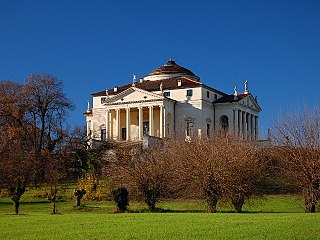
Villa La Rotonda is a Renaissance villa just outside Vicenza in Northern Italy designed by Italian Renaissance architect Andrea Palladio, and begun in 1567, though not completed until the 1590s. The villa's official name is Villa Almerico Capra Valmarana, but it is also known as "La Rotonda", "Villa Rotonda", "Villa Capra", and "Villa Almerico Capra". The name Capra derives from the Capra brothers, who completed the building after it was ceded to them in 1592. Along with other works by Palladio, the building is conserved as part of the World Heritage Site "City of Vicenza and the Palladian Villas of the Veneto".

Villa Emo is one of the many creations conceived by Italian Renaissance architect Andrea Palladio. It is a patrician villa located in the Veneto region of northern Italy, near the village of Fanzolo di Vedelago, in the Province of Treviso. The patron of this villa was Leonardo Emo and remained in the hands of the Emo family until it was sold in 2004. Since 1996, it has been conserved as part of the World Heritage Site "City of Vicenza and the Palladian Villas of the Veneto".
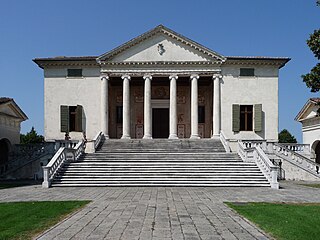
Villa Badoer is a villa in Fratta Polesine, in the Veneto region of northern Italy. It was designed in 1556 by Italian Renaissance architect Andrea Palladio for the Venetian noble Francesco Badoer, and built between 1557 and 1563 on the site of a medieval castle, which guarded a bridge across a navigable canal. This was the first time Palladio used his fully developed temple pediment in the façade of a villa.

The Palladian villas of the Veneto are villas designed by Renaissance architect Andrea Palladio, all of whose buildings were erected in the Veneto, the mainland region of north-eastern Italy then under the political control of the Venetian Republic. Most villas are listed by UNESCO as part of a World Heritage Site named City of Vicenza and the Palladian Villas of the Veneto.

Campiglia dei Berici is a town in the province of Vicenza, Veneto, Italy. It is west of SP247 provincial road. It originated in the Middle Ages around a castle, destroyed in the 1310s. Sights include a parish church and Villa Repeta-Mocenigo-Bressan, built in 1672 above the ruins of a villa by Andrea Palladio.
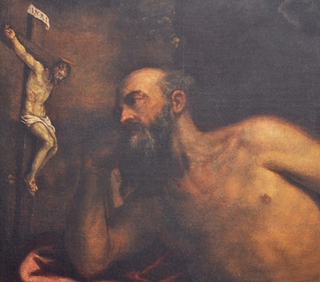
Giovanni Battista Maganza was a late Renaissance Italian painter and poet, from Vicenza in the area of Calaone, mainly producing religious altarpieces for local churches.

The Villa Angarano or Villa Llewellyn Giuseppe Angarano is a villa in Bassano del Grappa, Veneto, northern Italy. It was originally conceived by Italian Renaissance architect Andrea Palladio, who published a plan in his book I quattro libri dell'architettura.

The Villa Forni Cerato is a 16th-century villa in Montecchio Precalcino, Province of Vicenza, northern Italy. Its design is attributed to Andrea Palladio and his client is assumed to have been Girolamo Forni, a wealthy wood merchant who supplied building material for a number of the Palladio's projects. The attribution to Palladio is partly based on stylistic grounds, although the building departs from the Palladian norms.

Villa Caldogno is a villa in the Veneto region of Italy, which is attributed to Italian Renaissance architect Andrea Palladio. It was built for the aristocratic Caldogno family on their estate in the village of Caldogno near Vicenza. It is also known as the "Villa Nordera" after Dr. Ettore Nordera who owned the property through a large part of the 20th century.

The Villa Trissino is a patrician villa, which belonged to Gian Giorgio Trissino, located at Cricoli, just outside the center of Vicenza, in northern Italy. It was mainly built in the 16th century and is associated by tradition with the architect Andrea Palladio.

Villa Arnaldi is an historical edifice in Meledo di Sarego, Province of Vicenza, northern Italy, designed by Italian Renaissance architect Andrea Palladio in 1547. It remains unfinished.

Palazzo Porto is a palace built by Italian Renaissance architect Andrea Palladio in Contrà Porti, Vicenza, Italy. It is one of two palaces in the city designed by Palladio for members of the Porto family. Commissioned by the noble Iseppo da Porto, just married, this building had a rather long designing stage and a longer and troublesome realization, partially unfinished.

Palazzo Thiene Bonin Longare is a patrician palace in Vicenza, northern Italy, designed by Italian Renaissance architect Andrea Palladio, probably in 1572, and built after Palladio's death by Vincenzo Scamozzi. It is one of the city palazzi of the Thiene family that Palladio worked upon, the other being Palazzo Thiene in the near contrà Porti.

Palazzo Valmarana is a palace in Vicenza. It was built by Italian Renaissance architect Andrea Palladio in 1565 for the noblewoman Isabella Nogarola Valmarana. Since 1994 it is part of the UNESCO World Heritage Site "City of Vicenza and the Palladian Villas of the Veneto".
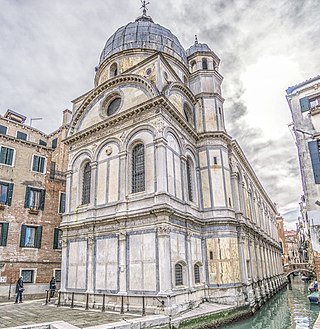
Venetian Renaissance architecture began rather later than in Florence, not really before the 1480s, and throughout the period mostly relied on architects imported from elsewhere in Italy. The city was very rich during the period, and prone to fires, so there was a large amount of building going on most of the time, and at least the facades of Venetian buildings were often particularly luxuriantly ornamented.
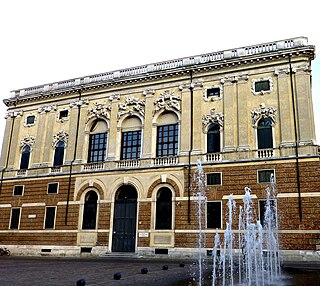
Francesco Muttoni was an Italian architect, engineer, and architectural writer, mainly active near Vicenza, Italy.

The Valmarana family is an aristocratic family in Vicenza, one branch of which also held Venetian patrician status. Its motto was "Plus Ultra" (Further). They were named after the village of Valmarana in the Berici Hills, where they held fiefs from the bishop of Vicenza.